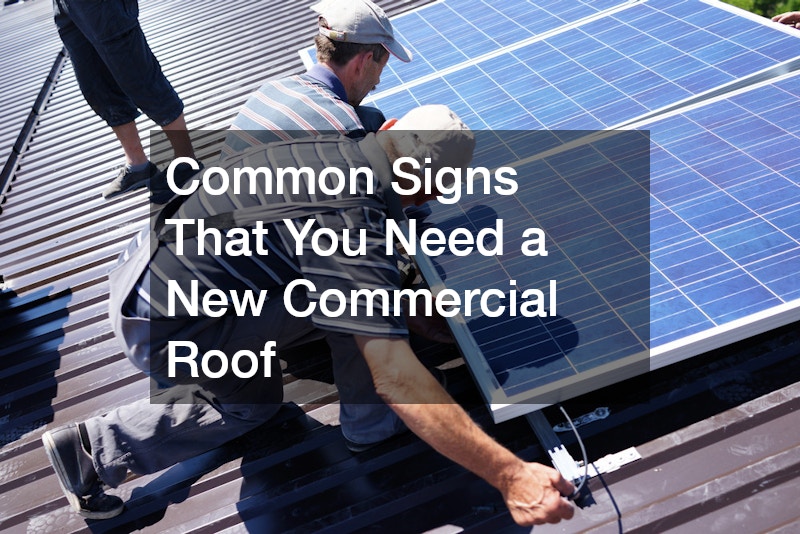A commercial roof is an essential component of any business building, providing protection from the elements and maintaining the structural integrity of the property. However, like any other part of a building, roofs have a limited lifespan, and signs of wear and tear may eventually appear. Knowing when it’s time to replace your roof can save you from costly repairs and potential damage to your business. Here are the most common signs that you may need a new commercial roof and why consulting a commercial roofing contractor is crucial for determining the best course of action.
1. Leaks and Water Damage
One of the most obvious signs that your commercial roof may need replacing is the presence of leaks. If you notice water stains on ceilings or walls, it’s a strong indicator that your roof is no longer effectively keeping moisture out.
Water can infiltrate your building through cracks, loose flashing, or damaged seams, and if left untreated, these leaks can lead to mold growth, structural damage, and compromised insulation.
Small leaks can sometimes be patched up by a commercial roofing contractor, but if leaks are widespread or persistent, it might be time to consider a full roof replacement. A professional inspection will help determine whether repair or replacement is the more cost-effective solution.
2. Visible Damage or Deterioration
Commercial roofs are subject to a variety of environmental factors, including heavy rain, wind, hail, and extreme temperatures. Over time, these elements can cause visible damage such as cracked, blistered, or punctured roofing materials. If you notice sections of your roof that appear damaged or worn, it’s essential to address the problem immediately.
Damaged roofing materials leave your building vulnerable to leaks and other issues that can worsen over time. A commercial roofing contractor can assess the extent of the damage and recommend whether repairs are possible or if a full replacement is necessary to prevent further deterioration.
3. Age of the Roof
Most commercial roofs have a lifespan of 20 to 30 years, depending on the materials used and the quality of installation. If your roof is nearing the end of its expected lifespan, it’s important to schedule an inspection with a commercial roofing contractor to evaluate its condition. Even if your roof looks fine from the ground, underlying issues could be developing that may lead to costly repairs or unexpected failures in the near future.
Proactively replacing an aging roof can save you from more extensive and expensive problems down the road. Additionally, newer roofing materials are often more energy-efficient, which can result in long-term savings on heating and cooling costs.
4. Increased Energy Bills
A failing roof can have a significant impact on your building’s energy efficiency. Commercial roofs are designed to provide insulation and maintain a consistent indoor temperature. If you’ve noticed a spike in your energy bills without any other explanation, it could be a sign that your roof’s insulation is no longer functioning as it should.
Damaged roofing materials or insulation can allow heat to escape in the winter and cool air to escape in the summer, forcing your HVAC system to work harder to maintain a comfortable environment. A commercial roofing contractor can inspect your roof’s insulation and recommend whether replacing the roof could improve energy efficiency and lower your utility costs.
5. Pooling Water
Flat commercial roofs are especially susceptible to water pooling or standing water after rain. Ideally, these roofs should have a slight slope to allow water to drain off effectively. However, over time, the slope can become compromised due to damage or settling, causing water to pool in certain areas.
Standing water can lead to roof deterioration, leaks, and even structural damage if left unaddressed. A commercial roofing contractor can assess the situation and determine whether repairs to the roof’s drainage system are enough or if a new roof with proper drainage is required.
6. Sagging or Structural Issues
A sagging roof is a serious red flag that should be addressed immediately. If sections of your commercial roof appear to be sagging or dipping, it may indicate underlying structural issues, such as water damage, compromised decking, or weakened supports. A sagging roof can pose a significant safety risk, as it may collapse if the damage worsens.
In such cases, a commercial roofing contractor will perform a thorough inspection to identify the cause of the sagging and recommend the best course of action, which could involve replacing the entire roof to ensure the structural integrity of the building.
Whether your roof is nearing the end of its lifespan or has suffered damage from the elements, working with an experienced commercial roofing contractor can help you determine the most cost-effective solution, whether that’s repairs or a complete roof replacement. By addressing roofing issues promptly, you can protect your business, reduce future costs, and ensure your building remains in top condition for years to come.
.


